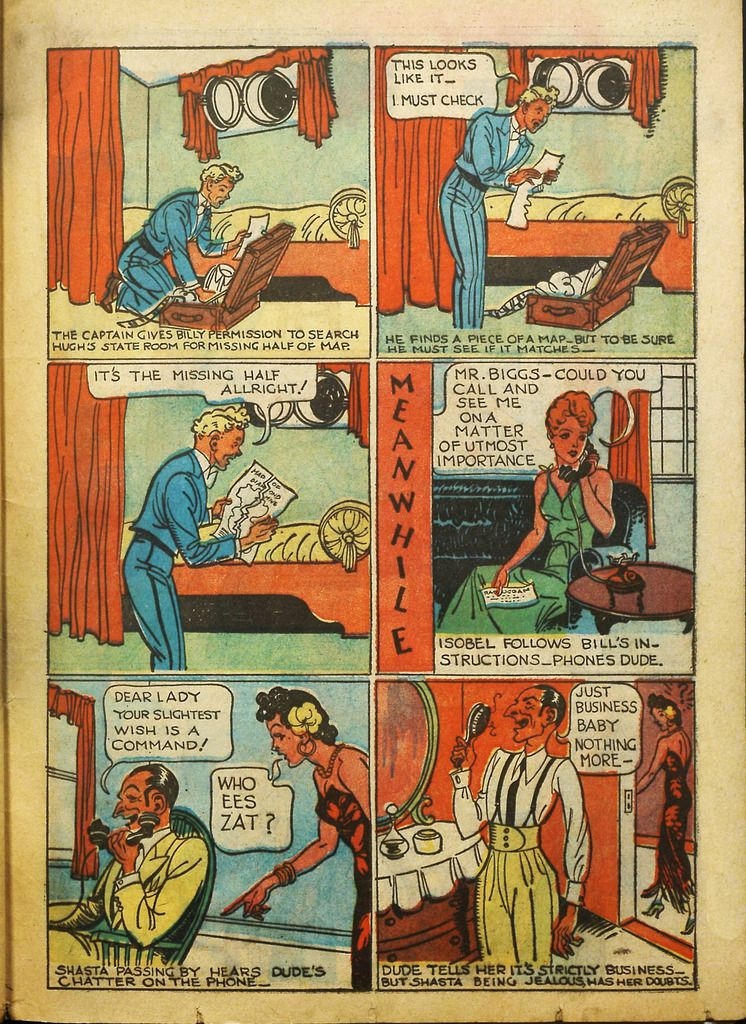|
|
Post by Batflunkie on Jun 23, 2016 12:54:57 GMT -5
Is there a term for the thinly lined, almost sketchy artstyle that was so prevelent in the late 30's/early 40's? Because I kind of enjoy it
|
|
|
|
Post by hondobrode on Jun 23, 2016 15:02:29 GMT -5
Can you share a pic of that style ?
|
|
|
|
Post by Batflunkie on Jun 23, 2016 23:48:51 GMT -5
Certainly!  |
|
|
|
Post by Deleted on Jun 24, 2016 9:49:25 GMT -5
Certainly!  That's one of the many reasons why I love Golden Age of Comics ... thanks for sharing that picture batflunkie! Perfection Indeed! |
|
|
|
Post by Batflunkie on Jun 24, 2016 10:07:21 GMT -5
Yeah, things like that kind of appeal to my minimalist tendencies as an artist
|
|
|
|
Post by hondobrode on Jun 24, 2016 18:49:03 GMT -5
Sorry, I don't know how to categorize that art, but I understand the appeal.
|
|
zilch
Full Member
Posts: 244 
|
Post by zilch on Jun 24, 2016 21:22:21 GMT -5
Mostly, Golden Age artists are inspired by (a less kind person would say swiped from) the leading comic strip artists of the day. You can find the influence of Alex Raymond in a LOT of these people. Then you get weirdies like H.G. Peter who seem to be based on even earlier artists.
Discuss.
|
|
|
|
Post by hondobrode on Jun 24, 2016 21:26:37 GMT -5
I like H.G. Peter's artwork, but you're right, it's fairly stylized and his own look.
|
|
|
|
Post by Roquefort Raider on Jun 24, 2016 21:51:57 GMT -5
Rhodey is called "colonel" in the latest Captain Marvel preview.
I assume that's just another move to make the comics more like the movies, but did James really go back to the army in the comics and get a big promotion? I know he was an agent of some kind a few years ago when Marvel decided to turn him into a cyborg and to clone him and stuff (ugh) but I haven't really followed his career recently.
*edit*
Oops, never mind... it was on his wikipedia page.
|
|
|
|
Post by Icctrombone on Jun 24, 2016 23:51:48 GMT -5
Rhodey is called "colonel" in the latest Captain Marvel preview. I assume that's just another move to make the comics more like the movies, but did James really go back to the army in the comics and get a big promotion? I know he was an agent of some kind a few years ago when Marvel decided to turn him into a cyborg and to clone him and stuff (ugh) but I haven't really followed his career recently. *edit* Oops, never mind... it was on his wikipedia page. All this about Rhodey comes as a shock to me. Cyborg? Wow. |
|
|
|
Post by chadwilliam on Jun 25, 2016 0:45:33 GMT -5
Not sure how well known this is but Peter was in his early 60s when he started with comic books. So if his stuff looks as though it were influenced by an earlier period it's likely due to his becoming an artist in the 19th century.
Anyhow, count me amongst his fans.
|
|
|
|
Post by Cei-U! on Jun 25, 2016 10:42:20 GMT -5
Peter's art could actually be quite nice, as seen in his work for Hyper Publications in 1940, though definitely in an older tradition of illustration. His work on Wonder Woman is deliberately designed to evoke the line art on ancient Greek pottery. I don't have time to dig up an example right now but I will be including a side-by-side comparison in my book that will clearly demonstrate my point.  Cei-U! I summon the unique talent |
|
|
|
Post by hondobrode on Jun 25, 2016 11:48:37 GMT -5
Thanks for the info both of you !
|
|
|
|
Post by Batflunkie on Jun 25, 2016 12:27:52 GMT -5
Mostly, Golden Age artists are inspired by (a less kind person would say swiped from) the leading comic strip artists of the day Which, in hindsight, almost seems like a complete no-brainer on my part. I think that the origins of comic strips sometimes aren't as appreciated or as well understood as their four-color brothern, or at least not as much as they should be |
|
|
|
Post by Farrar on Jun 25, 2016 14:00:01 GMT -5
Not sure how well known this is but Peter was in his early 60s when he started with comic books. So if his stuff looks as though it were influenced by an earlier period it's likely due to his becoming an artist in the 19th century. Anyhow, count me amongst his fans. Yes; and also, Peter was specifically recruited by Marston and Mayer for the WW comic due to his experience in drawing suffrage cartoons that appeared in magazines/newspaper editorials. (Much more on his background can be found in Jill Lepore's fascinating book The Secret History of Wonder Woman.) And count me in as a Peter fan too! |
|